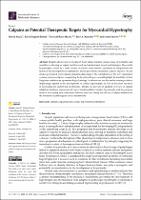Calpains as Potential Therapeutic Targets for Myocardial Hypertrophy
Author
Date
2022-04Permanent link
https://hdl.handle.net/11351/8042DOI
10.3390/ijms23084103
ISSN
1422-0067
WOS
000785143600001
PMID
35456920
Abstract
Despite advances in its treatment, heart failure remains a major cause of morbidity and mortality, evidencing an urgent need for novel mechanism-based targets and strategies. Myocardial hypertrophy, caused by a wide variety of chronic stress stimuli, represents an independent risk factor for the development of heart failure, and its prevention constitutes a clinical objective. Recent studies performed in preclinical animal models support the contribution of the Ca2+-dependent cysteine proteases calpains in regulating the hypertrophic process and highlight the feasibility of their long-term inhibition as a pharmacological strategy. In this review, we discuss the existing evidence implicating calpains in the development of cardiac hypertrophy, as well as the latest advances in unraveling the underlying mechanisms. Finally, we provide an updated overview of calpain inhibitors that have been explored in preclinical models of cardiac hypertrophy and the progress made in developing new compounds that may serve for testing the efficacy of calpain inhibition in the treatment of pathological cardiac hypertrophy.
Keywords
Calpain; Calpastatin; Myocardial hypertrophyBibliographic citation
Aluja D, Delgado-Tomás S, Ruiz-Meana M, Barrabés JA, Inserte J. Calpains as Potential Therapeutic Targets for Myocardial Hypertrophy. Int J Mol Sci. 2022 Apr;23(8):4103.
Audience
Professionals
This item appears in following collections
- HVH - Articles científics [4476]
- VHIR - Articles científics [1751]
The following license files are associated with this item:

 Private area
Private area Contact Us
Contact Us








